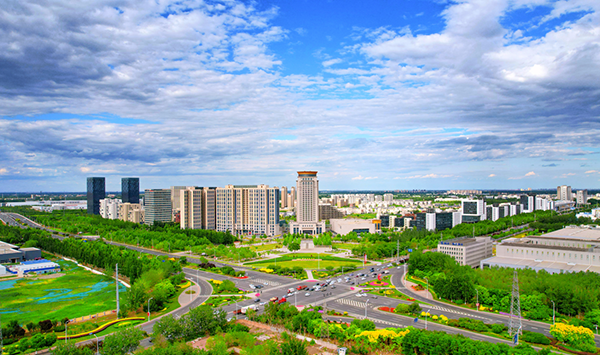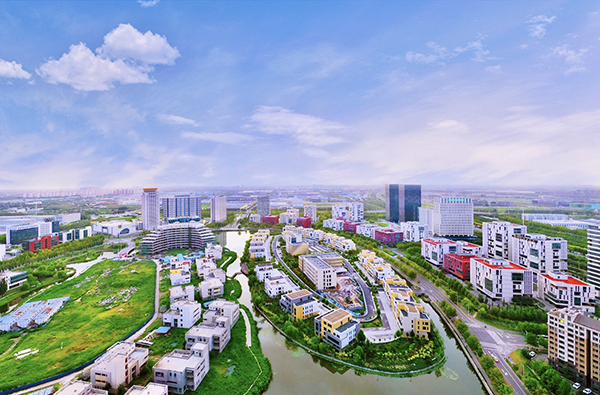
The China Tianjin Wuqing Development Area (UDA) was established on December 28, 1991. It is recognized as a national-level economic and technological development area, a national-level high-tech industrial park, and the core region of the Tianjin National Independent Innovation Demonstration Zone. The developed area spans 40 square kilometers.
It benefits from exceptional geographical advantages and is of the closest proximity to Beijing among all areas in Tianjin, serving as a significant node in the Beijing-Tianjin development axis and an integral component of the central core functional area. It is situated 71 kilometers from downtown Beijing, 30 kilometers from downtown Tianjin, 90 kilometers from Beijing Capital International Airport, 45 kilometers from Beijing Daxing International Airport, 35 kilometers from Tianjin Binhai International Airport, and 71 kilometers from Tianjin Port.
The transportation system is highly accessible and convenient. Within a 15-minute drive, there are four highways, including Beijing-Tianjin-Tanggu, Beijing-Tianjin, Beijing-Shanghai, and Binhai-Baoding highways, featuring a total of six entrances and exits. The area is equipped with one station for the Beijing-Tianjin intercity railway, as well as passenger and freight stations for the Beijing-Shanhaiguan Railway. National Highway 103 and 104 pass through the region. The Tongzhou-Wuqing-Langfang urban and suburban railway project is progressing rapidly, and the comprehensive transportation network of the "Nine Horizontal and Nine Vertical" highways ensures seamless connectivity.

The natural ecological environment is favorable. The area is bordered by the Beijing-Hangzhou Canal to the east, with the Longfeng New River to the north and the old course of the Longfeng River to the west. Nestled in the middle is the picturesque Tian'e Lake, encompassing a centrally located 46.67-hectare lake park designed in a wetland style. The park boasts a green coverage rate of 42%, and its air and water quality surpass national standards. Over the years, strict environmental protection standards have been upheld, allowing only environmentally compliant enterprises to settle in the area. In 2019, it was designated as the sole municipal-level ecological industrial park in Tianjin.
The service environment is of high quality and efficiency. There is a project service center in the development area, providing free full-process agency for project procedures. Additionally, there are such institutions as a customs, tax and talent exchange center, a human resources service center, and a financial center.
The supporting facilities are well-equipped. There are large-scale commercial office buildings, conference centers, star-rated hotels, hot spring apartments, high-tech apartments, international schools, tertiary hospitals, theme parks, Outlets,, Wanda Plaza, and more, providing services for conferences, accommodation, dining, medical care, and leisure.
The scientific and technological innovation system is well-established. It has been approved as a national pilot park for patents, an international health industry demonstration zone, Tianjin's demonstration base for innovation and entrepreneurship, Tianjin's entrepreneurial park for international students, and Tianjin's human resources industry park. There are currently 51 university and research institute projects, 144 national-level high-tech enterprises, 33 municipal-level research and development institutions and platforms, 6 leading and nurturing enterprises at the municipal level, and 6 incubators and co-working spaces at or above the municipal level in the area. It has nurtured 10 specialized and innovative new enterprises. The development area has one university and one national vocational school, attracting high-end and innovative talents. At the same time, it has established postdoctoral research workstations, academician workstations, and expert service bases providing strong intellectual support or enterprise technological innovation.
There are multiple policy advantages, including preferential policies to support enterprise development, talent policies, and technology policies. The park also explores equity investment models to provide comprehensive support for enterprise development.

Since its establishment, a total investment of 138 billion yuan has been attracted to the area (including 6.28 billion US dollars in foreign investment), with more than 4,000 companies from over 50 countries and regions, including 45 Fortune 500 companies, over 100 leading foreign companies, and over 120 leading domestic companies. It has formed three dominant industries: intelligent technology, biomedicine, and modern services.
The UDA serves as the window for Wuqing district's external opening, leading innovation, driving transformation, and supporting development. In 2021, the general budget revenue reached 2.35 billion yuan for the whole year, with a total industrial output value of 47.63 billion yuan for industries above designated size, wholesale and retail sales of 58.91 billion yuan, and fixed asset investment of 17.47 billion yuan.
In terms of industrial development, it aims to gather industrial elements and comprehensively build a new ecosystem for industrial development. With the core of the new generation information technology industry, it is accelerating the technological transformation of the traditional equipment manufacturing industry and establishing its own intelligent technology industry. With precision medicine as the core, focusing on the research, development, and production of medical devices and biopharmaceuticals, it aims to build a first-class domestic biopharmaceutical industry cluster. With a focus on Internet audio-visual, financial services, and headquarters economy, it comprehensively enhances the level of development in the modern service industry.
In terms of spatial layout, based on the development concept of "integration of people, production, and the city," it follows the principles of intensive and efficient development, the block division of labor, axis and belt support, and the integration of "people, production, and the city." It coordinates the development of the three major spaces of production, living, and ecology, and focuses on creating a spatial layout of "one axis, two zones, and one valley."
In terms of managing and operating key facilities, the primary focus is on the China-Europe Industrial Park, Entrepreneurship Headquarters Base, International Enterprise Community, and the key development area in the western region.






